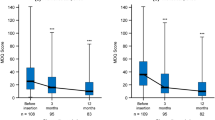Abstract
Objective
The aim of our study was to examine the effect of the levonorgestrel-releasing intrauterine system (LNG-IUS) treatment on depressive symptoms, changes in bleeding patterns, and quality of life (QoL) among premenopausal women in our clinic.
Materials and methods
We recruited 120 premenopausal women, aged 18–50 years, who had sought care in the previous year for menorrhagia. LNG-IUS was inserted into eligible patients after the relevant evaluations. Both questionnaires were administered at time of the initial screening before and 6 months after insertion of the LNG-IUS. All patients completed the 36-item Short-Form Health Survey (SF-36) for QoL and Beck’s Depression Inventory for depressive symptoms.
Results
At the 6-month follow-up visit, the pictorial blood assessment chart score (PBAC) considerably decreased (p < 0.001). For SF-36 scores, physical functioning, physical role limitations, emotional role limitations, bodily pain, vitality, and mental health scores improved significantly after treatment (p < 0.001). Depression scores showed no significant difference from baseline to 6 months (p = 0.375).
Conclusion
The LNG-IUS for the treatment of menorrhagia increases the QoL, and depression scores did not increase significantly in 6 months.


Similar content being viewed by others
References
Shapley M, Jordan K, Croft PR (2004) An epidemiological survey of symptoms of menstrual loss in the community. Br J Gen Pract 54:359–363
Coulter A, Peto V, Jenkinson C (1994) Quality of life and patient satisfaction following treatment for menorrhagia. Fam Pract 11:394–401
Hurskainen R, Teperi J, Rissanen P, Aalto AM, Grenman S, Kivela A et al (2001) Quality of life and cost-effectiveness of levonorgestrel-releasing intrauterine system versus hysterectomy for treatment of menorrhagia: a randomised trial. Lancet 357:273–277
National Institute for Health and Care Excellence (NICE) (2007) Heavy menstrual bleeding: full clinical guideline 44. NICE, London. Available from: http://www.nice.org.uk/nicemedia/live/11002/30401/30401.pdf
Cote I, Jacobs P, Cumming D (2002) Work loss associated with increased menstrual loss in the United States. Obstet Gynecol 100:683–687
Hallberg L, Hogdahl AM, Nilsson L, Rybo G (1966) Menstrual blood loss and iron deficiency. Acta Med Scand 180:639–650
Coulter A, Bradlow J, Agass M, Martin-Bates C, Tulloch A (1991) Outcomes of referrals to gynaecology outpatient clinics for menstrual problems: an audit of general practice records. Br J Obstet Gynaecol 98:789–796
Bhattacharya S, Middleton LJ, Tsourapas A, Lee AJ, Champaneria R, Daniels JP et al (2011) Hysterectomy, endometrial ablation and Mirena® for heavy menstrual bleeding: a systematic review of clinical effectiveness and cost-effectiveness analysis. Health Technol Assess 15(19):1–252 iii–xvi
Marjoribanks J, Lethaby A, Farquhar C (2006) Surgery versus medical therapy for heavy menstrual bleeding. Cochrane Database Syst Rev (2):CD003855
National Advisory Committee on Health and Disability (1998) Guidelines for the management of heavy menstrual bleeding. New Zealand: NACHD
Lethaby AE, Cooke I, Rees M (2005) Progesterone or progestogen-releasing intrauterine systems for heavy menstrual bleeding. Cochrane Database Syst Rev (4):CD002126
Higham JM, O’Brien PM, Shaw RW (1990) Assessment of menstrual blood loss using a pictorial chart. Br J Obstet Gynaecol 97:734–739
Beck AT, Beck RW (1972) Screening depressed patients in family practice. A rapid technic. Postgrad Med 52(6):81–85
Ware JE (1993) SF-36 health survey: manual and interpretation guide. New England Medical Center, Boston
Jenkinson C, Peto V, Coulter A (1994) Measuring change over time: a comparison of results from a global single item of health status and the multi-dimensional SF-36 health status survey questionnaire in patients presenting with menorrhagia. Qual Life Res 3:317–321
Keshavarz H, Hillis SD, Kieke BA, Marchbanks PA (2002) Hysterectomy surveillance United States, 1994–1999. MMWR CDC Surveill Summ 51:1–8
Clarke A, Black N, Rowe P, Mott S, Howie K (1995) Indications for and outcome of total abdominal hysterectomy for benign disease: a prospective cohort study. Br J Obstet Gynaecol 102:611–620
Middleton LJ, Champaneria R, Daniels JP, Bhattacharya S, Cooper KG, Hilken NH et al (2010) Hysterectomy, endometrial destruction, and levonorgestrel releasing intrauterine system (Mirena®) for heavy menstrual bleeding: systematic review and meta-analysis of data from individual patients. BMJ 341:c3929
Luukkainen T (2000) The levonorgestrel intrauterine system: therapeutic aspects. Steroids 65:699–702
Andersson K, Batar I, Rybo G (1992) Return to fertility after removal of a levonorgestrel-releasing intrauterine device and Nova-T. Contraception 46:575–584
Belhadj H, Sivin I, Diaz S et al (1986) Recovery of fertility after use of the levonorgestrel 20 mcg/d or Copper T 380 Ag intrauterine device. Contraception 34:261–267
Higham JM, Shaw RW (1999) Clinical associations with objective menstrual blood volume. Eur J Obstet Gynecol Reprod Biol 82(1):73–76
Hurskainen R, Teperi J, Rissanen P, Aalto AM, Grenman S, Kivelä A, Kujansuu E, Vuorma S, Yliskoski M, Paavonen J (2004) Clinical outcomes and costs with the levonorgestrel releasing intrauterine system or hysterectomy for treatment of menorrhagia: randomized trial 5-year follow up. JAMA 291(12):1456–1463
Gemzell-Danielsson K, Inki P, Boubli L, O’Flynn M, Kunz M, Heikinheimo O (2010) Bleeding pattern and safety of consecutive use of the levonorgestrel-releasing intrauterine system (LNG-IUS)—a multicentre prospective study. Hum Reprod 25:354–359
Backman T, Huhtala S, Luoto R, Tuominen J, Rauramo I, Koskenvuo M (2002) Advance information improves user satisfaction with the levonorgestrel intrauterine system. Obstet Gynecol 99:608–613
Conflict of interest
The authors report no conflict of interest.
Author information
Authors and Affiliations
Corresponding author
Additional information
Implications: The LNG-IUS not only corrects some of the physical problems experienced by patients who have unwanted irregular menstrual periods, namely menorrhagia, but also is effective in improving many psychological parameters, either directly or indirectly.
Rights and permissions
About this article
Cite this article
Tazegül Pekin, A., Seçilmiş Kerimoğlu, Ö., Kebapcılar, A.G. et al. Depressive symptomatology and quality of life assessment among women using the levonorgestrel-releasing intrauterine system: an observational study. Arch Gynecol Obstet 290, 507–511 (2014). https://doi.org/10.1007/s00404-014-3237-1
Received:
Accepted:
Published:
Issue Date:
DOI: https://doi.org/10.1007/s00404-014-3237-1



